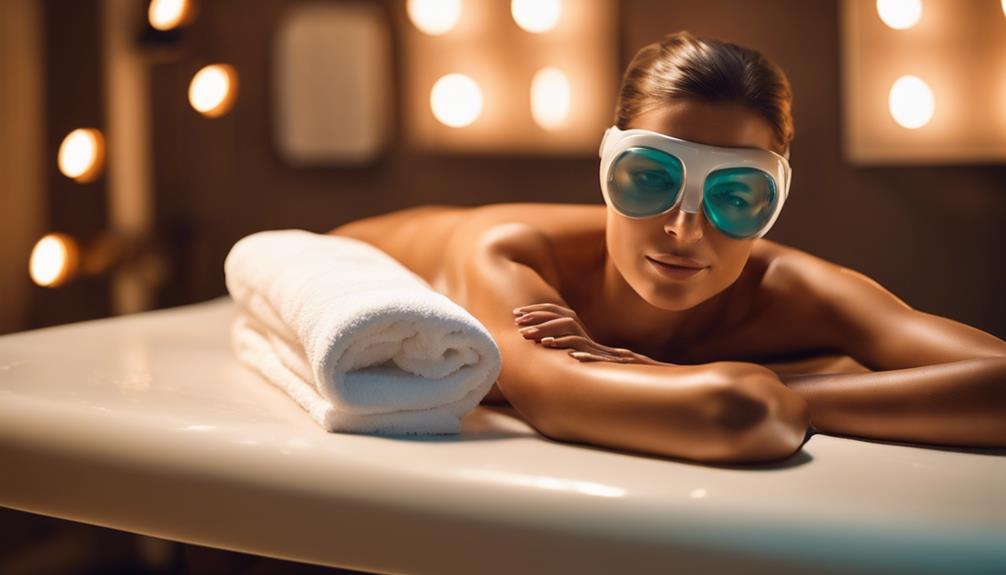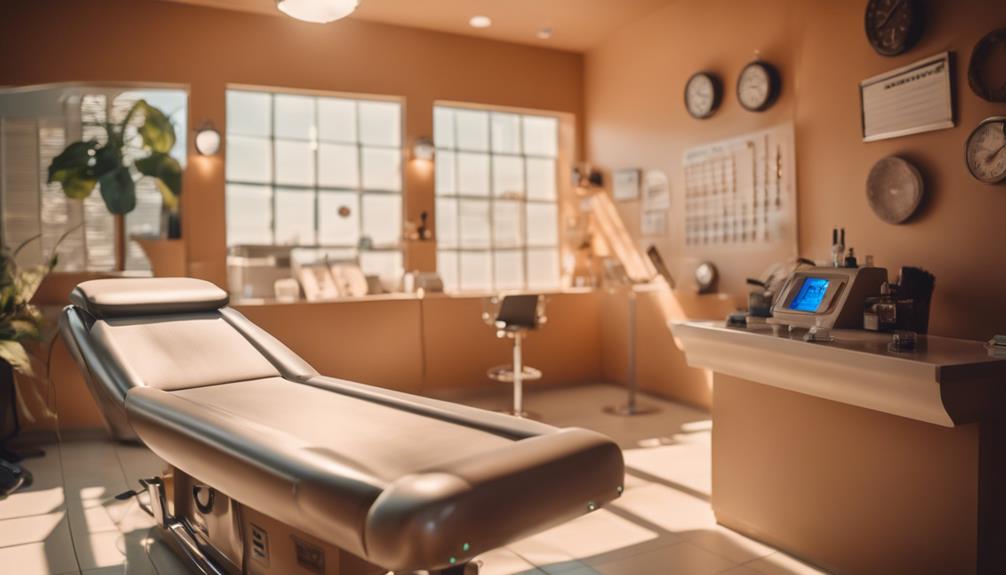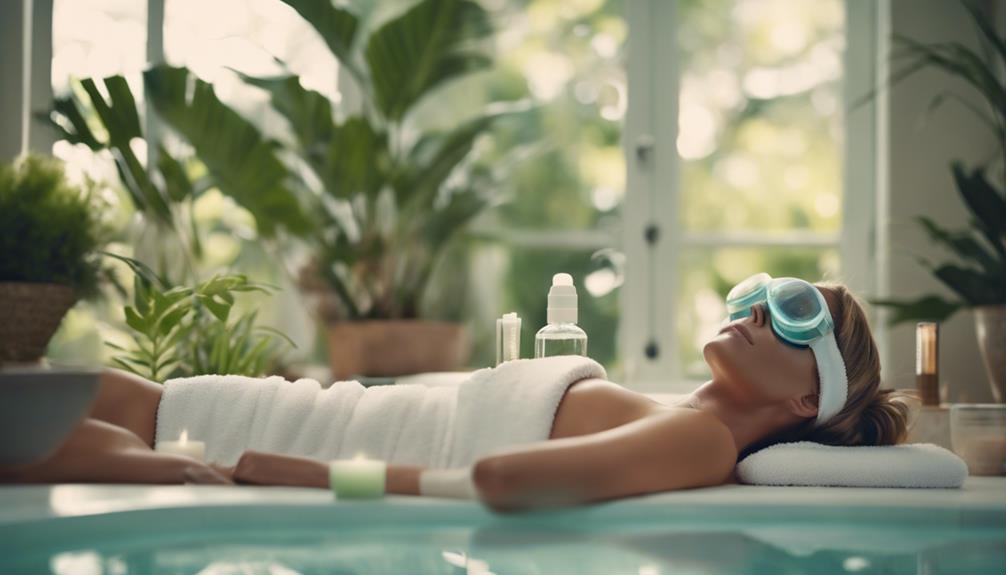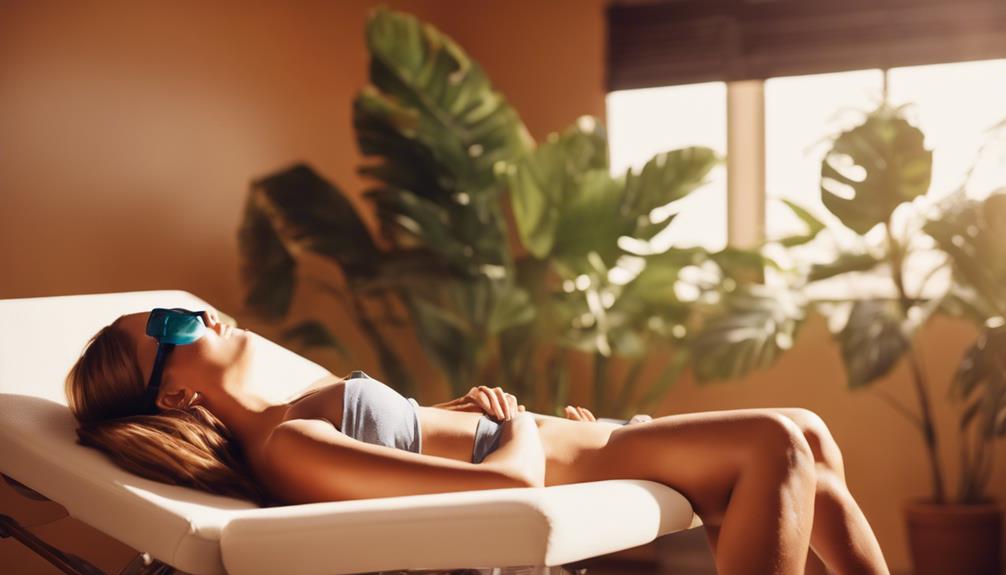To stay safe while using tanning beds, start by knowing your skin type. Always wear protective goggles to shield your eyes from harmful UV rays. Take short sessions at first—3-5 minutes is best for beginners—and gradually increase your time based on your skin's reaction. Make sure to use lotions designed for tanning beds to keep your skin hydrated. After your session, moisturize to lock in hydration and apply aloe vera for soothing relief. Be mindful of any medications that could increase skin sensitivity, and adjust your tanning practices accordingly. There's more to discover about enhancing your tanning safely.
Key Takeaways
- Always wear UV-blocking goggles to protect your eyes from harmful rays during tanning sessions.
- Start with short sessions of 3-5 minutes and gradually increase based on your skin's response.
- Consult with your healthcare provider about any medications that may increase skin sensitivity to UV exposure.
- Use tanning lotions specifically designed for tanning beds to ensure even application and hydration.
Understanding Skin Types
Understanding your skin type is essential for tailoring your tanning routine and minimizing the risk of sunburn and skin damage. Start by evaluating whether you have fair, medium, or dark skin, as this will dictate your UV exposure levels.
Identify any sensitivity you might have to the sun, which can increase your risk of sunburn and skin cancer. It's wise to consult a tanning expert for personalized advice tailored to your specific skin type.
Prior to tanning, prepare your skin by showering, shaving, and exfoliating at least a day in advance. Use a non-oil-based moisturizer to hydrate your skin effectively.
Don't forget to remove makeup, jewelry, and fragrances to guarantee an even tan while prioritizing your skin's health.
Medication Awareness
Be mindful of how certain medications can increase your skin's sensitivity to UV rays, making it essential to consult a healthcare provider before tanning. Some medications can heighten the risk of sunburn or skin damage, so it's important to stay informed.
Here are four key points to take into account:
- Identify Photosensitizing Medications: Some antibiotics, anti-inflammatory drugs, and certain herbal supplements can cause photosensitivity.
- Discuss Risks with Your Doctor: Always talk about your tanning plans and any medications you're taking.
- Monitor Your Skin's Reaction: Pay attention to how your skin responds during and after tanning.
- Stay Hydrated: Keep your skin moisturized to help it cope with UV exposure.
Being aware can help you tan safely!
Protective Measures

To protect your skin and eyes from harmful UV rays while tanning, it's crucial to choose the right clothing and eyewear. Wearing snug swimwear or protective clothing helps prevent uneven tanning, while UV-blocking goggles shield your eyes from damage. You can also use tanning stickers to monitor your bronzing progress. Always follow the salon's dress code to stay comfortable and safe during your session.
| Protective Measure | Purpose | Tips |
|---|---|---|
| UV-blocking goggles | Shield eyes from UV rays | Guarantee a snug fit |
| Snug swimwear | Prevent uneven tanning | Choose a comfortable style |
| Tanning stickers | Monitor bronzing progress | Place on visible areas |
Tanning Lotions Selection
Choosing the right indoor tanning lotion is crucial for achieving a deep, even tan while protecting your skin from dryness and damage. Here are four key factors to ponder when selecting your tanning lotion:
- Hydration: Look for lotions that hydrate your skin to prevent dryness during tanning.
- Ingredients: Opt for products containing aloe vera, vitamins, and natural oils for added nourishment.
- Bronzers: Reflect on using bronzers that enhance melanin production, giving you a richer color.
- Compatibility: Always choose lotions designed specifically for tanning beds to avoid damaging your skin.
Applying your chosen lotion in circular motions guarantees even distribution, especially on dry areas.
Prioritizing the right products will help you achieve that beautiful tan while keeping your skin healthy.
Session Guidelines

Understanding how to effectively manage your tanning bed sessions is just as important as selecting the right lotion for your skin.
Start with short sessions of 3-5 minutes, especially if you're a beginner. This will help you gauge your skin's reaction and avoid overexposure.
Gradually increase your time in the bed based on how your skin responds, but always keep your skin's UV tolerance in mind.
Remember to wear protective goggles during every session to shield your eyes from harmful rays.
It's essential to monitor your skin closely for any signs of irritation or discomfort. If you notice any issues, consider reducing your session time or taking a break.
Prioritizing these guidelines will help you achieve a safe, beautiful tan.
Post-Tanning Care
Proper post-tanning care is essential for maintaining your skin's hydration and extending the life of your tan.
After your session, focus on these key steps to keep your skin healthy and glowing:
- Moisturize: Apply a rich moisturizer to lock in hydration and prevent dryness.
- Hydrate: Drink plenty of water to keep your skin supple and vibrant.
- Use Aloe Vera: This soothing gel helps calm your skin and prolongs your tan.
- Gentle Cleansing: Avoid harsh soaps; opt for mild cleansers to maintain your tan's longevity.
Safety Practices

Maintaining skin health is essential to protect against UV damage while tanning.
Start by gradually increasing your tanning sessions to minimize risks. Understand your skin type and its UV tolerance; this knowledge helps you avoid overexposure.
Always wear high-quality tanning bed goggles to shield your eyes from harmful rays. Stay informed about how any medications you're taking may interact with UV exposure, as some can make your skin more sensitive.
Additionally, consider healthier alternatives to traditional tanning beds if you're worried about safety.
Finally, keep your skin hydrated and moisturized before and after tanning to promote a glowing complexion.
Frequently Asked Questions
How Often Should I Use Tanning Beds for Best Results?
You should use tanning beds 2-3 times a week, gradually increasing session time as your skin builds tolerance. Always monitor your skin's reaction, ensuring you avoid overexposure to maintain healthy skin while achieving desired results.
Can I Tan if I Have a Sunburn?
Tanning with a sunburn? That's like pouring gasoline on a fire! You shouldn't tan until your skin heals. Give it time to recover; otherwise, you'll risk serious damage and more painful burns.
What Should I Do if I Experience a Tanning Bed Rash?
If you experience a tanning bed rash, stop using the bed immediately. Apply a soothing lotion, keep the area moisturized, and consider consulting a dermatologist if the rash persists or worsens. Your skin's health is vital.
Are There Age Restrictions for Using Tanning Beds?
You might think age restrictions for tanning beds don't exist, but they do. Most salons require users to be at least 18 years old, ensuring safety and minimizing risks associated with skin damage in younger individuals.
How Can I Tell if a Tanning Salon Is Reputable?
To tell if a tanning salon's reputable, check for cleanliness, staff qualifications, and customer reviews. Make certain they use proper equipment, offer skin assessments, and prioritize safety measures. Don't hesitate to ask questions before choosing.
Conclusion
As you commence your tanning journey, remember that safety's key to a glowing outcome.
By knowing your skin type, being mindful of medications, and using the right products, you can avoid unnecessary risks.
Think of this process as walking a tightrope—balance is vital.
Follow the session guidelines and prioritize post-tanning care to keep your skin hydrated and radiant.
With these essential tips, you'll not only achieve that sun-kissed look but also protect your skin's health along the way!









